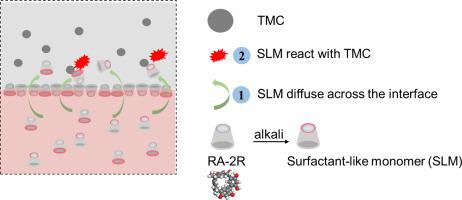Desalination ( IF 8.3 ) Pub Date : 2022-04-10 , DOI: 10.1016/j.desal.2022.115774 Quan Hu 1 , Dongsheng Li 2 , Suilin Liu 3 , Guangming Yan 3 , Jie Yang 3, 4 , Gang Zhang 3, 4

|
To meet separation need under various conditions, a great variety of membranes have been fabricated via interfacial polymerization (IP), especially for the polyester membranes with intrinsic micro-porosity. However, the aqueous phase used for making those polyester membranes often requires alkaline environment, resulting in a quite different procedure compared with conventional polyamide membranes, which may alter IP process that have been widely studied. Here, the KOH, NaOH and LiOH were used respectively to create alkaline environment whereby the impact of alkali on polyester membranes were investigated systematically. It was found that the alkali not only showed influence on the IP process, but it also affected diffusion of monomers in aqueous phase across the water/hexane interface. When the concentration of alkali or pH of the aqueous phase were the same, the membranes using KOH as base were found to have the lowest permeability while the membranes using NaOH showed the highest permeability, and the membranes using LiOH showed the moderate permeability. The mechanism of the permeance trend was further investigated in detail, and it was found that the monomer containing hydroxyl not only could act as IP monomers, but also could play role as surfactant, thus affected its own diffusion to organic phase. This study paves the way for a wider integration of these macrocyclic polyphenols in the field of high-performance nanofiltration (NF) membranes, and also offers a new approach to optimize the performance of NF membranes based on polyester.
中文翻译:

碱对基于环状多酚的纳滤聚酯膜的影响
为了满足各种条件下的分离需要,已经通过界面聚合(IP)制备了多种膜,特别是对于具有固有微孔率的聚酯膜。然而,用于制造这些聚酯膜的水相通常需要碱性环境,与传统的聚酰胺膜相比,这导致了完全不同的过程,这可能会改变已被广泛研究的 IP 工艺。在这里,分别使用 KOH、NaOH 和 LiOH 来创造碱性环境,从而系统地研究了碱对聚酯膜的影响。发现碱不仅对 IP 过程有影响,而且还影响单体在水相中穿过水/己烷界面的扩散。当水相的碱浓度或pH值相同时,以KOH为碱的膜的渗透性最低,而以NaOH为碱的膜渗透性最高,而以LiOH为碱的膜渗透性适中。进一步详细研究了渗透趋势的机理,发现含羟基的单体不仅可以作为IP单体,还可以起到表面活性剂的作用,从而影响其自身向有机相的扩散。该研究为这些大环多酚在高性能纳滤(NF)膜领域更广泛的整合铺平了道路,也为优化基于聚酯的纳滤膜的性能提供了一种新方法。发现使用 KOH 作为碱的膜具有最低的渗透性,而使用 NaOH 的膜显示出最高的渗透性,使用 LiOH 的膜显示出中等的渗透性。进一步详细研究了渗透趋势的机理,发现含羟基的单体不仅可以作为IP单体,还可以起到表面活性剂的作用,从而影响其自身向有机相的扩散。该研究为这些大环多酚在高性能纳滤(NF)膜领域更广泛的整合铺平了道路,也为优化基于聚酯的纳滤膜的性能提供了一种新方法。发现使用 KOH 作为碱的膜具有最低的渗透性,而使用 NaOH 的膜显示出最高的渗透性,使用 LiOH 的膜显示出中等的渗透性。进一步详细研究了渗透趋势的机理,发现含羟基的单体不仅可以作为IP单体,还可以起到表面活性剂的作用,从而影响其自身向有机相的扩散。该研究为这些大环多酚在高性能纳滤(NF)膜领域更广泛的整合铺平了道路,也为优化基于聚酯的纳滤膜的性能提供了一种新方法。进一步详细研究了渗透趋势的机理,发现含羟基的单体不仅可以作为IP单体,还可以起到表面活性剂的作用,从而影响其自身向有机相的扩散。该研究为这些大环多酚在高性能纳滤(NF)膜领域更广泛的整合铺平了道路,也为优化基于聚酯的纳滤膜的性能提供了一种新方法。进一步详细研究了渗透趋势的机理,发现含羟基的单体不仅可以作为IP单体,还可以起到表面活性剂的作用,从而影响其自身向有机相的扩散。该研究为这些大环多酚在高性能纳滤(NF)膜领域更广泛的整合铺平了道路,也为优化基于聚酯的纳滤膜的性能提供了一种新方法。











































 京公网安备 11010802027423号
京公网安备 11010802027423号